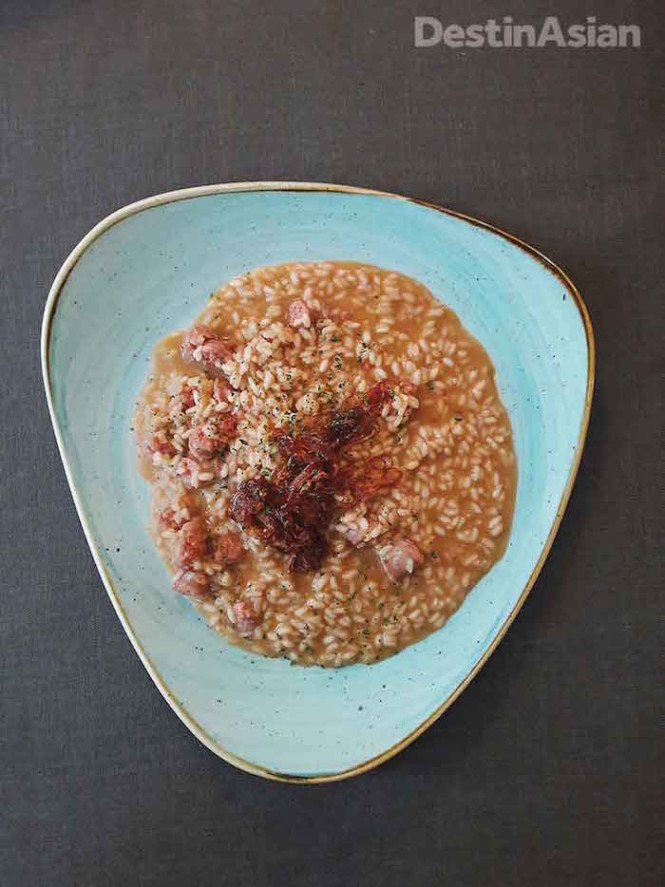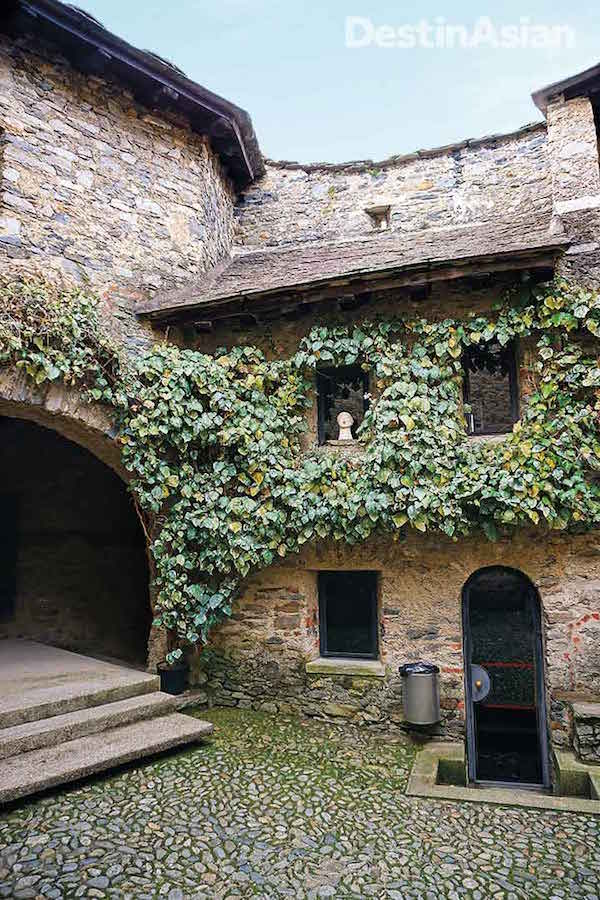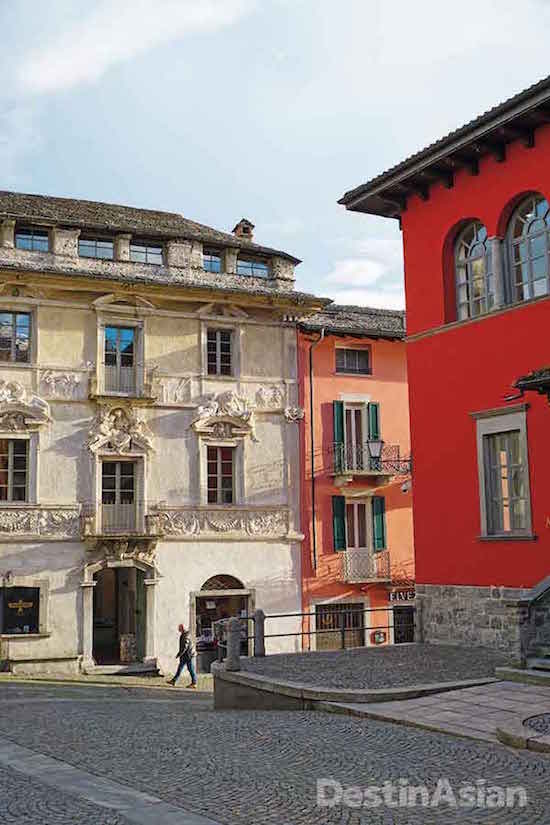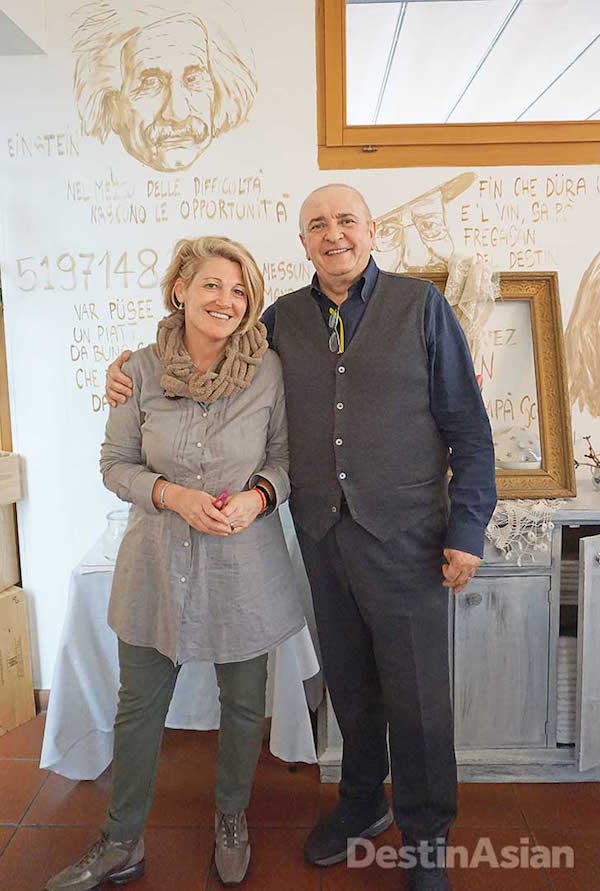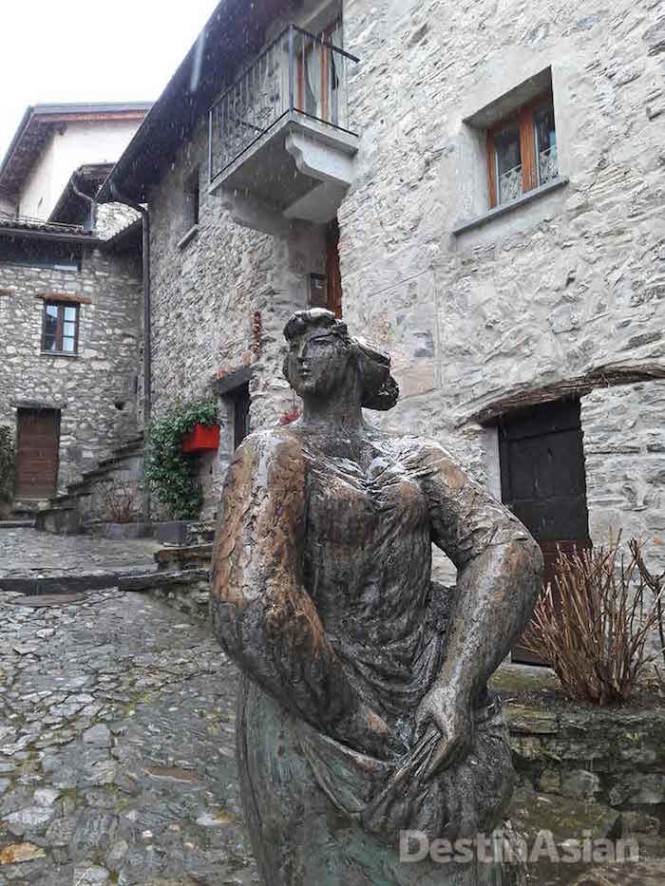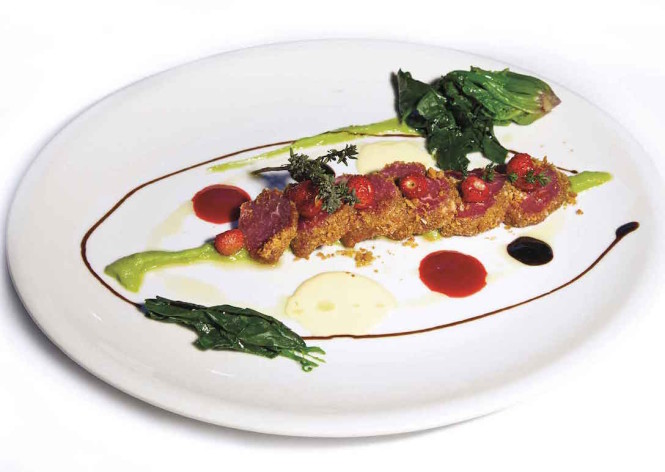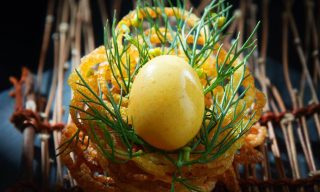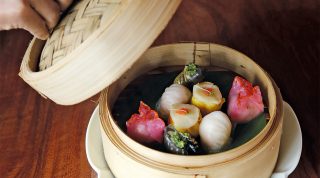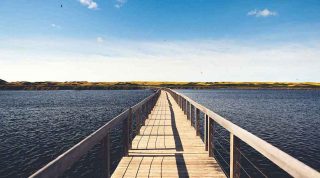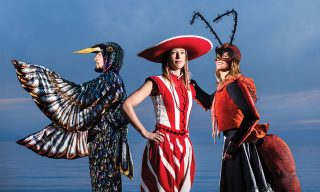Forget fondue: foodies with an appetite for la dolce vita — Swiss-style — will want to cross the Alps to the country’s Italian-speaking canton, where the flavors are as distinct as they are delicious.
Amid the oak and maple trees of Lugano’s lakeside Parco Civico sits a statue of the dying Socrates, a copy of an 1876 effigy by Russian sculptor Mark Matvey-evich Antokolski. Poor old Socrates is slumped in a chair, bearded chin against his chest, arms slack at his sides, feet splayed, a hint of a paunch below the alabaster creases of his toga. I know the ancient Greek philosopher is meant to be dead, or almost dead, from hemlock poisoning. But to me—and this is probably because I’ve just wrapped up an immoderate gastro-tour and am on the edge of a food coma myself—he looks more like he’s nodded off peacefully at the dinner table after a huge feast.
It’s a bad joke, I know, but I won’t apologize for suggesting that Ticino, Switzerland’s Italian-speaking canton, is the most tantalizing culinary destination in the country. Don’t get me wrong: I like a good schnitzel and a pot of fondue as much as the next guy. Yet the food in Ticino, informed in part by the spare rusticity of Alpine fare but largely by the culinary traditions and spirit of northern Italy, tastes like nowhere else.
“Look down this lake and what do you see?” says local guide Marina Guzman the next day in Ascona, on the shores of border-straddling Lake Maggiore. “Over there is Piedmont. On the other side, Lombardy. Polenta, risotto. Two great Italian cuisines on our doorstep. This is what makes Ticinese food so distinct.”
“You go through the tunnel, and it is another world,” concurs Patricia Carminati, the woman who devised my half-day food tour of Lugano, Ticino’s largest city. She’s referring to the newly opened Gotthard Base Tunnel, a 57-kilometer railway tunnel—the deepest and longest in the world—bored through the Alps between the German-speaking canton of Uri and the mountain valleys of northern Ticino. Seventeen years in the making, it shaves 45 minutes off the commute between Zurich and Lugano, though if you’re not in a hurry, the old route over the Gotthard Pass is the more scenic option. Regardless, her point is that when it comes to culture and food, Ticino, which was once ruled by the dukes of Milan, is neither entirely Swiss nor entirely Italian, but something of a happy hybrid.
Patricia herself sounds Italian (at least to my ears) and talks a lot with her hands, yet she’s Swiss-minded when it comes to things like punctuality, politics, and the benefits of a working infrastructure. On the matter of food, however, her cultural compass clearly points to the south. “We Ticinese live to eat, like the Italians,” she says.
My early arrival in Lugano via the Gotthard tunnel means Patricia and I can start our tour before noon. Meeting in the lobby of the Grand Hotel Villa Castagnola shortly after I check in, we walk for 20 minutes into the city’s historic center, a warren of arcaded lanes and compact flagstone piazzas that gives way to the plane-tree-lined waterfront of Lake Lugano. First on the agenda is Negozi Gabbani, an 80-year-old macelleria (butcher shop) and salumeria where we park ourselves at a waiting corner table under a ceiling hung with ham legs for a taste of the deli’s best charcuterie and cheese, accompanied by a meaty house merlot. Next comes Restaurant Cantinone on Piazza Cioccaro for more wine and antipasti (octopus carpaccio; dense little croissants that we eat with a tangy cheese dip), followed by a stop in an arcade on boutique-lined Via Nassa at a place called Bernasconi. The street, Patricia explains as we sip a sparkling spumante from nearby Locarno, is named for the traditional fish traps—nassa—used by the fishermen who once lived here, long before the city’s bourgeoisie, grown rich on trade with Como and Milan, transformed it into a stretch of grand townhouses. There’s certainly nothing fishy about our apericena platter: balls of fried polenta, salty bresaola (dried beef) with goat’s cheese, and cuts of pastry-wrapped luganighetta, a juicy Piedmont-style pork sausage.
For something sweet, we then head to the venerable Grand Café Al Porto, which has been in business since 1803. Part of the building
used to be a medieval convent, and the old refectory upstairs (now reserved for private dinners) sports its original 16th-century wooden ceiling and frescoes by the Florentine painter Carlo Bonafedi. Another treasure? The café’s amaretti biscuits, flavored with Swiss chocolate and kirsch.
Our last stop is the Antica Osteria del Porto. Set above the Cassarate River near where it flows into Lake Lugano, the mustard-yellow building dates to the 19th century, when it served as a warehouse for stones and other building materials being shipped across the water. Today, it’s a genial terrace restaurant run by an affable gentleman named Mario Gandolfi, who plies us with fried lake fish, spoonfuls of soft cow’s cheese on onion marmalade, sugar-dusted apple tarts, and a miraculous walnut liqueur called nocino.
Stuffed by the end of it all, I say ciao to Mario and Patricia and decide to burn off some calories by walking the long way round to my hotel through Parco Civico, where I encounter the aforementioned statue. Hello, Socrates—I know how you feel. That night, I skip dinner.
Monte Brè is a small mountain to the northeast of town, serviced by a funicular that starts not far from my hotel. I head up there for an early lunch the next day on the recommendation of Villa Castagnola’s gracious front desk manager, who enthuses about both the views and the art at Brè Village, on the summit’s wooded eastern slopes. A cluster of old stone houses, Brè is also something of an outdoor museum; various artists from Hungarian painter Jozeph Birò to Brè’s own Pasquale Gilardi lived here in the 20th century, and their legacy is commemorated with a series of modern sculptures and mosaic works installed around the village. There’s also a newish restaurant that I’m keen to check out, Salotto Brè. It’s Saturday and the place is completely besieged by regulars, and for good reason: the menu looks to local produce and seasonal selvaggina (wild game) and delivers a heart-warming taste of the mountains. Under the gaze of the village’s Romanesque church tower, I greedily devour a soulful deer-sausage risotto and a boar stew as dark and rich as the merlot that accompanies it.
The rest of the afternoon I spend touring Ascona, 90 minutes away by train and bus via Locarno. At 196 meters above sea level, this is Switzerland’s lowest lying town; it’s also the smallest and most charming of Ticino’s lake resorts. Backed by mountainsides draped in chestnut trees and fronting the sailboat-dotted waters of Lake Maggiore, Ascona exudes as much of a Mediterranean air as anywhere in the canton, with Liberty-style villas and swaying palms and a promenade lined with sun-kissed restaurant terraces and fadingly grand hotels. It’s where streams of Swiss-Germans come to play out their Italian fantasies without leaving home. And it’s also home to Monte Verità (“Mountain of Truth”), where a group of anarchists and artists established a hilltop Utopian colony in the early 20th century, catering to fantasies of a different sort. “Crazy nudists,” my guide scoffs. The site is now run as a conference hotel and museum.
Back in Lugano, art and food unite once again at Arté al Lago, Villa Castagnola’s posh lakeside ristorante and the only place in town with a Michelin star. It also bills itself as a gallery; on display during my visit are explosive resin sculptures by Venetian artist Annaluigia Boeretto. The Mediterranean-leaning dishes are just as pretty: foie-gras mousse and a standout scampi are followed by sea bass laced with nutty argan oil atop a cockle- and chickpea-studded pool of parsley jus. And for dessert? An ingenious and entirely delicious ricotta meringue drizzled with acacia honey and topped by a glistening sphere of pomegranate sherbet.
I leave the lake district the next day to visit the cantonal capital of Bellinzona, about 30 minutes up the tracks from Lugano. There are at least two reasons for one to make the trip: the town’s Saturday farmers’ market (which I’ve just missed); and its three UNESCO-listed castles: Castelgrande, Montebello, and Sasso Corbaro. Strung out across the Ticino River valley at the base of the Lepontine Alps, the medieval fortifications were built by the Milanese as a bulwark against Swiss raiders from Uri. If you climb to the top of Castelgrande’s 14th-century Black Tower on a blustery day when the wind comes howling down the valley, you get a sense of what it must have felt like to be standing on these battlements during the rush of an oncoming army. As it turns out, it was the French who defeated Bellinzona, charging up from Milan in 1499. Just a few months later, the town’s citizenry rebelled, throwing in their lot with the Swiss Confederacy.
Hungry after my castle tour, I head to Grottino Ticinese for lunch. Unique to Ticino are its grotti, village taverns whose forerunners were actual caves used for storing wines and cured meats. Today the term grotto appears in the name of all sorts of different restaurants, but the idea is that they serve simple, sturdy food. That’s certainly the case at Grottino Ticinese, which occupies an old stone building 10 minutes by foot from the city center. I order a rustic pizzoccheri buckwheat pasta with chard and “fondue” cheese and a peppery mound of beef tartare. Chef-owner Dario Joppini is a tireless host; after mixing my tartare to taste, he moves around tables of birdlike old women asking, “Can I get you some more, dear?” with a smooth charm that belies his former career as a Swissair steward.
Back in Lugano, things are pretty quiet on a Sunday afternoon. With nothing much better to do, I sit in on a vespers organ recital (Bach, Buxtehude, Pachelbel) at the 15th-century church of Santa Maria degli Angioli, where you can also admire a magnificent early-Renaissance fresco depicting the crucifixion of Christ. Just a few steps away, there’s the LAC (Lugano Arte e Cultura), a strikingly modern cultural center that debuted in 2015. It houses a theater, concert hall, and museum, though the only part open today is the basement gallery, which hosts a permanent collection of contemporary artworks from Lugano’s Museo d’arte della Svizzera Italiana.
And I eat. My last dinner in Ticino is at Ristorante Orologio, a century-old establishment in downtown Lugano that has been recently taken over by sommelier Savino Angioletti. As you might expect, the wine list is impressive (I opt for a bottle of local white merlot from Mendrisio, just across the border from Italy), and so too is the food: maltagliati pasta made from chestnuts and served with cream chickpea and turnip greens, followed by an elegant tagliata di carne cruda di cervo—slices of raw venison with pistachio sauce and wild strawberries. Perfetto.
The Details
Where to Stay
Grand Hotel Villa Castagnola
Lugano’s top-rated hotel occupies an Italian-style villa overlooking the lake. In business since the 1880s, it features old-world drawing rooms,
semitropical gardens, and 74 uniquely decorated rooms and suites. Viale Castagnola 31; 41-91/973-2555; doubles from US$442.
Where to Eat
Antica Osteria del Porto
Via Foce 9; 41-91/971-4200
GastroSnack Bernasconi
Via Nassa 7; 41-91/967-3013
Grand Café Al Porto
Via Pessina 3; 41-91/910-5130
Grottino Ticinese
Via Lavizzari 1, Bellinzona; 41-91/826-3964;
Negozi Gabbani
Via Pessina; 41-91/911-3080.
Restaurant Cantinone
Piazza Cioccaro 8; 41-91/923-1068.
Restaurant Arté al Lago
Piazza Emilio Bossi 7; 41-91/973-4800.
Ristorante Orologio
Via Giovanni Nizzola 2; 41-91/923-2338;
Salotto Brè
Via Brè 46; 41-91/971-5000;
Take the Tour
To sign up for Patricia Carminati’s Food & Wine Tour Lugano, call her direct at 41-76/616-6842 or email tours-in-ticino@bluewin.ch.
This article originally appeared in the April/May 2017 print issue of DestinAsian magazine (“A Taste of Ticino”).

